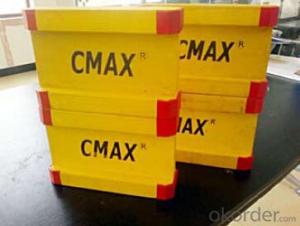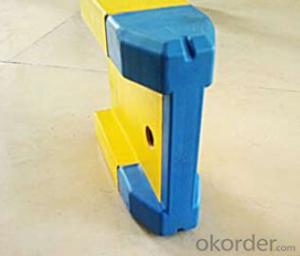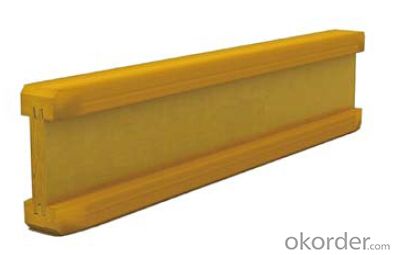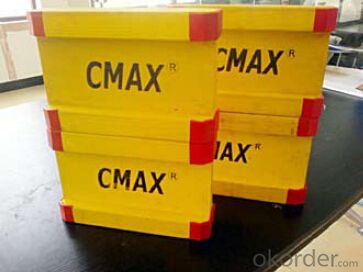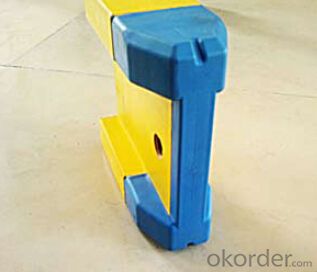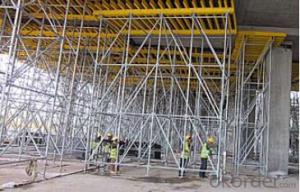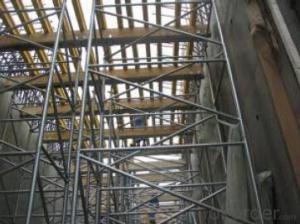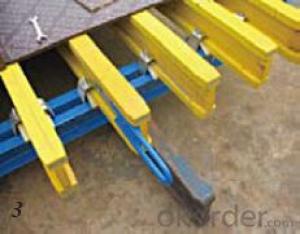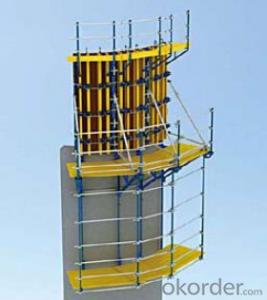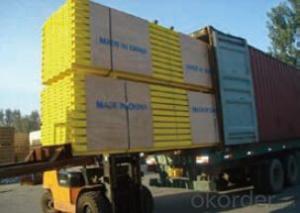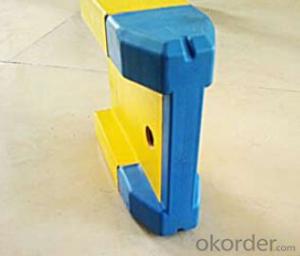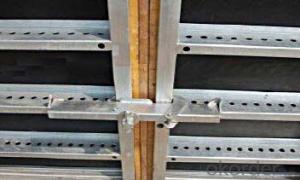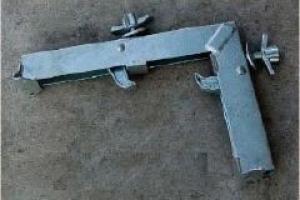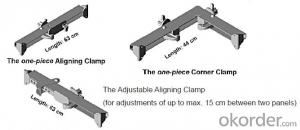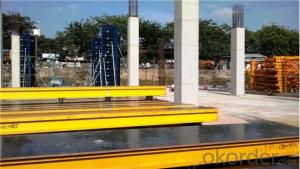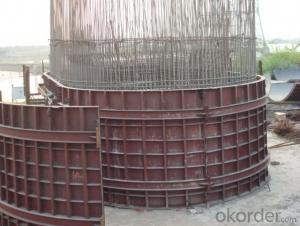Timber-Beam Formwork for Building Construction
- Loading Port:
- Tianjin
- Payment Terms:
- TT OR LC
- Min Order Qty:
- 50 m²
- Supply Capability:
- 1000 m²/month
OKorder Service Pledge
Quality Product, Order Online Tracking, Timely Delivery
OKorder Financial Service
Credit Rating, Credit Services, Credit Purchasing
You Might Also Like
Characteristics:
◆ Standardized production lines.
Supply capability: 3000m/day, Lmax = 6600mm.
◆ Finger jointing of the flange and web, the strength of timber beam is highly improved.
Max. shearing force failure load:40KN
◆ Well treated to prevent from water penetration or erosion, so the service life maximally
extended.
Normally, CNBM timber beam H20 can be used for 4 to 5 years, the exact using time would
depend on maintenance & storage.
◆ Robust caps at the end of the girders protect against damages.
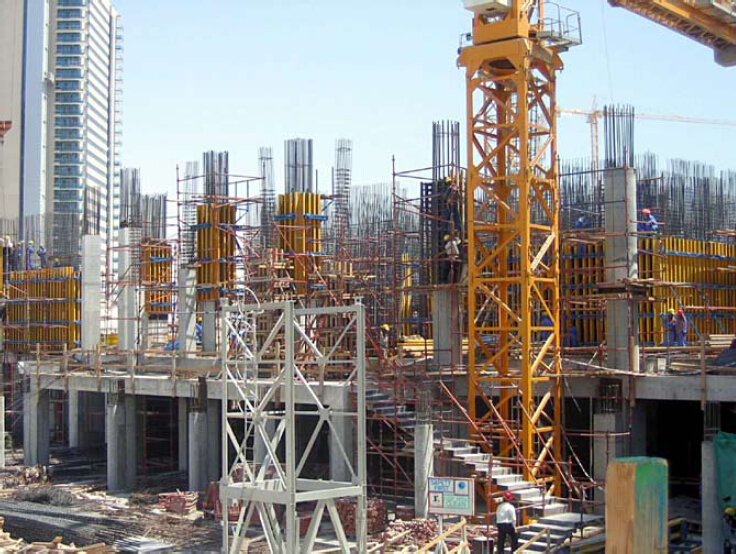
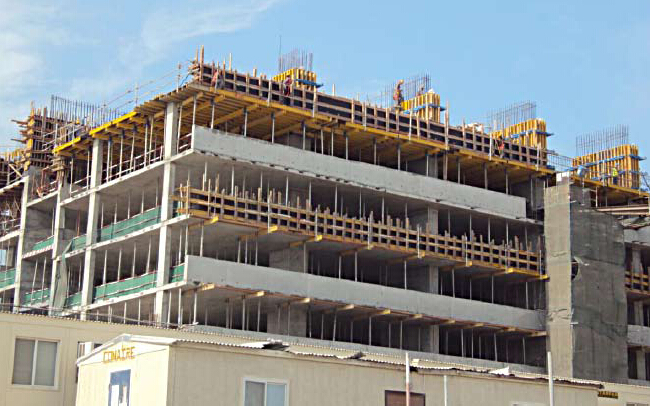
- Q: How does steel formwork affect the overall energy efficiency of a structure?
- Steel formwork can significantly improve the overall energy efficiency of a structure. It provides a durable and reusable framework for concrete pouring, reducing material waste and construction time. The precise fit of steel formwork minimizes the need for additional insulation, resulting in better thermal performance and reduced energy consumption for heating and cooling. Additionally, its strength and stability allow for the construction of thinner walls and slabs, maximizing the usable space and minimizing the amount of materials required. Thus, steel formwork positively impacts the energy efficiency of a structure by reducing energy consumption and promoting sustainable construction practices.
- Q: Can steel formwork be used in precast concrete applications?
- Yes, steel formwork can be used in precast concrete applications. Steel is a versatile and durable material that can withstand the pressures and forces exerted during the precasting process. It provides excellent support and stability to the concrete during pouring and curing. Steel formwork also allows for precise shaping and detailing of the concrete elements, ensuring accurate dimensions and a high-quality finish. Additionally, steel formwork can be easily assembled and disassembled, making it a suitable choice for repetitive and fast-paced precast production. Overall, steel formwork is widely used in precast concrete applications due to its strength, versatility, and ease of use.
- Q: Can steel formwork be used for precast concrete beams?
- Indeed, precast concrete beams can utilize steel formwork. Demonstrating durability and rigidity, steel formwork effectively endures the weight and pressure exerted by the concrete during casting. It furnishes a seamless and uniform surface to facilitate pouring the concrete, guaranteeing the anticipated shape and dimensions of the beam. Moreover, steel formwork enables effortless demolding and reusability, rendering it a financially prudent option for manufacturing precast concrete beams.
- Q: Can steel formwork be used for both reinforced and non-reinforced concrete structures?
- Absolutely! Steel formwork is applicable to both reinforced and non-reinforced concrete structures. This flexible and long-lasting choice can endure the immense pressure generated by the concrete during pouring. Moreover, it can be effortlessly put together and taken apart, making it ideal for diverse construction undertakings. Whether it's a reinforced structure necessitating supplementary reinforcement bar support or a non-reinforced structure requiring a temporary mold, steel formwork proves effective in either scenario. Its robustness and steadiness enable the achievement of accurate shapes and measurements, guaranteeing the desired result for any concrete structure.
- Q: What are the common safety certifications for steel formwork systems?
- The common safety certifications for steel formwork systems include ISO 9001:2015, OHSAS 18001, and EN 12811-1.
- Q: Can steel formwork be used for road construction?
- Yes, steel formwork can be used for road construction. Steel formwork is a popular choice for road construction projects due to its durability, strength, and versatility. It is capable of withstanding heavy loads and pressure, making it suitable for creating sturdy and long-lasting road surfaces. Steel formwork can be easily assembled and disassembled, allowing for efficient construction processes and faster project completion. Additionally, steel formwork can be reused multiple times, making it a cost-effective option for road construction.
- Q: How does steel formwork handle different concrete bleeding rates?
- Steel formwork handles different concrete bleeding rates by providing a rigid and strong structure that can contain and support the concrete during the pouring and curing process. It helps to prevent excessive bleeding and segregation of the concrete, ensuring uniformity and strength in the final structure. The smooth surface of steel formwork also helps in reducing the amount of bleed water that escapes, resulting in better surface finish of the concrete.
- Q: How does steel formwork handle construction joints?
- Steel formwork handles construction joints by providing a strong and rigid framework that can be easily adjusted and aligned to accommodate the formation of joints. It allows for precise placement and alignment of the formwork, ensuring that the joints are properly supported and reinforced. Additionally, steel formwork can be easily dismantled and reassembled, making it efficient for handling construction joints during the entire construction process.
- Q: What are the typical maintenance requirements for steel formwork systems?
- The maintenance requirements for steel formwork systems can vary depending on the specific design and usage. However, there are some typical maintenance tasks that should be performed to ensure the optimal performance and longevity of these systems. Firstly, regular cleaning is essential for steel formwork. After each use, the formwork should be thoroughly cleaned to remove any concrete residue or other debris. This can be done using water and a brush or high-pressure cleaning equipment. It is important to remove all traces of concrete to prevent build-up and potential damage to the steel. Additionally, inspection of the formwork is crucial to identify any signs of wear or damage. Regular inspections can help detect any issues early on and prevent them from escalating into more significant problems. This includes checking for cracks, dents, or bent components that may compromise the formwork's integrity or affect its alignment. Furthermore, lubrication of movable parts is necessary to ensure smooth operation. Steel formwork systems often have adjustable components like clamps, connectors, or locking mechanisms that may need lubrication to prevent friction and facilitate easy adjustments. Applying a suitable lubricant to these parts will help maintain their functionality and prevent them from becoming stuck or difficult to operate. It is also important to store the steel formwork properly when not in use. This typically involves storing the components in a dry and well-ventilated area to prevent corrosion. Moisture can cause rust and deterioration of the steel, so it is crucial to keep the formwork away from areas with high humidity or direct exposure to water. Lastly, regular maintenance should include periodic reconditioning or repair of any damaged or worn-out parts. This may involve replacing worn-out components, reinforcing weak areas, or welding any cracks or fractures. Performing these repairs promptly helps maintain the structural integrity of the formwork and ensures its safe and reliable operation during subsequent uses. Overall, by following these typical maintenance requirements such as cleaning, inspection, lubrication, proper storage, and timely repairs, the steel formwork systems can be kept in excellent condition, extending their lifespan and ensuring their performance and safety in construction projects.
- Q: Can steel formwork be used in bridge construction?
- Yes, steel formwork can be used in bridge construction. Steel formwork is a durable and versatile option that can withstand the heavy loads and harsh environmental conditions associated with bridge construction. It offers the required strength and stability to support the concrete during the construction process, ensuring the bridge's structural integrity. Additionally, steel formwork can be easily assembled, disassembled, and reused, making it a cost-effective choice for bridge construction projects.
Send your message to us
Timber-Beam Formwork for Building Construction
- Loading Port:
- Tianjin
- Payment Terms:
- TT OR LC
- Min Order Qty:
- 50 m²
- Supply Capability:
- 1000 m²/month
OKorder Service Pledge
Quality Product, Order Online Tracking, Timely Delivery
OKorder Financial Service
Credit Rating, Credit Services, Credit Purchasing
Similar products
Hot products
Hot Searches

